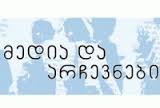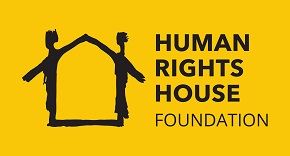International Election Observation Mission on Improved Pre-Election Media Environment
October 29, 2013

Media.Ge
International election observation mission, having conducted monitoring of the 27 October Presidential Election in Georgia,consider the media environment more open than during the 2012 elections and journalists are noted as covering major political events in a more inclusive manner, reads the statement of preliminary findings and conclusions released on October 28.
This Statement of Preliminary Findings and Conclusions is the result of a common endeavour involving the OSCE Office for Democratic Institutions and Human Rights (OSCE/ODIHR), the OSCE Parliamentary Assembly (OSCE PA), the Parliamentary Assembly of the Council of Europe (PACE), the European Parliament (EP) and the NATO Parliamentary Assembly (NATO PA).
Below please find the section of the report assessing pre-election media environment.
National TV remains the prime source of information for the overwhelming majority of voters. Print media outlets offer a wider spectrum of views; however, they have limited influence and are gradually being replaced by online media.
The improved media environment provided voters with a wide range of views through talk-shows, free airtime and debates. However, critical analysis and analytical reporting is still lacking. Candidates were provided with a platform to present their programs and opinions freely. Newscasts provided daily coverage of the main contestants, although they were more focused on the everyday campaign activities of the candidates rather than their respective platforms.
The law created two categories of candidates; those who qualify for free airtime and those who do not.22 This distinction provided significant benefit to qualified candidates and limited the ability of non-qualified candidates to campaign on the same level. Non-qualified candidates criticized this distinction as arbitrary in the context of the presidential election and held a press conference calling for equal conditions for media coverage and state funding for all candidates.
Despite this, prominent non-qualified candidates received considerable coverage in the news and talk-shows. In a positive development, starting from 10 October, the Georgian Public Broadcaster (GPB) included Ms. Burjanadze on the list of candidates who qualified for free airtime based on public opinion polls.23 By contrast, private broadcasters chose not to allocate free airtime to her.
GPB-1 organized two debates among different qualified candidates on 17 and 18 October. Ms. Burjanadze chose not to participate in debates because she was not included in the first grouping, which included the candidates Mr. Margvelashvili and Mr. Bakradze. Only Ms. Burjanadze actively purchased airtime on national TV, while Mr. Bakradze, Mr. Chikhladze, Ms. Kirtadze, and Mr. Margvelashvili purchased a limited number of advertisements. While entitled, the UNM and GD-DG did not use their allocated state funding for advertising on private TV stations.24
The OSCE/ODIHR EOM monitoring showed that media outlets focused more on the activities of the parliamentary political parties and the government than on the activities of specific candidates.25
In addition, all major national TV stations broadcast live three meetings lasting over 11 hours in total between the Prime Minister and political experts and journalists. During these meetings and two lengthy interviews on GPB-1 and Imedi, the Prime Minister criticized the work of the experts and journalists in covering the government and election, and openly campaigned for Mr. Margvelashvili, effectively providing him with additional airtime.
Only the GPB-1 provided qualified candidates with equitable coverage. In its newscasts GPB-1 provided similar proportions (from 12 to 15 per cent of election-related coverage) to Mr. Bakradze, Ms. Burjanadze, Mr. Margvelashvili and Mr. Targamadze. Mr. Davitashvili, Mr. Kharatishvili, Mr. Mzhavia and the non-qualified candidates, Ms. Kirtadze and Mr. Natelashvili each received from six to eight per cent.
The newscasts of all private broadcasters monitored by the OSCE/ODIHR EOM mainly focused on the activities of Mr. Margvelashvili and Mr. Bakradze. TV Maestro devoted similar proportions of coverage to both candidates, which was mainly neutral in tone. While Rustavi 2 and Imedi were mainly positive and neutral when covering both candidates, they devoted more time to Mr. Bakradze. TV Kavkasia favored Mr. Margvelashvili both in tone and the amount of coverage. Additionally, private broadcasters provided significant coverage to Ms. Burjanadze and Mr. Targamadze, which was mainly neutral in tone.
Batumi-based TV Adjara focused more on regional issues, providing limited coverage of the campaign activities of the candidates. When TV Adjara did cover the campaign, it clearly favored Mr. Margvelashvili, who received 14 per cent of mostly positive coverage, while none of the other candidates received more than 8 per cent of similar coverage. In its newscasts, TV Adjara included profiles of all candidates and presented their background and main election messages.
The Georgian National Communications Commission (GNCC) is the key media regulatory body responsible for overseeing the activities of the broadcast media. The GNCC did not present any interim monitoring results and intended to release its first interim report shortly after election day. It informed the OSCE/ODIHR EOM that it did not receive any election-related complaints, but identified one minor violation related to the airing of political advertisements.
NOTE
22 Free airtime (60 seconds per hour on public broadcasters, and 90 seconds per three hours on private broadcasters) was allocated to each political party that received either four per cent in the last parliamentary elections or three per cent in the last local elections. This included Giorgi Margvelashvili (GD-DG) Davit Bakradze (UNM), Koba Davitashvili (People’s Party), Sergo Javakhidze (Movement “For Fair Georgia”), Giorgi Targamadze (Christian-Democratic Movement), Zurab Kharatishvili (European Democrats), and Teimuraz Mzhavia (Christian-Democratic People’s Party).
23 A political party that receives more than four per cent in an opinion poll held no later than a month before the election may be allocated free airtime.
***
24 According to the Law on Political Unions of Citizens, extra funding for TV advertisements is awarded to parties that qualify for general state funding and have nominated a presidential candidate. The UNM and GD-DG are the only parties that meet these criteria and are entitled to GEL 600,000 and 100,000, respectively.
25 The monitoring was conducted from 23 September until 26 October and focused on primetime hours (18:00 -24:00). The media outlets monitored included: GPB-1, TV Adjara, Rustavi-2, Imedi, Maestro, and Kavkasia.
News
December 13, 2023
Ethnic minorities outside the peace dialogue
November 6, 2023
‘Peace’ agenda of political parties
Popular
Articles
February 13, 2024



